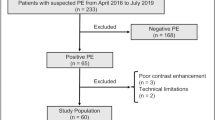Abstract
Objective
According to the international registry ICOPER, right ventricular (RV) dysfunction is the most significant predictor of mortality in patients with pulmonary embolism (PE).
Aim
To identify the most informative indicators of gated blood pool single photon emission computer tomography (GBP-SPECT) for evaluation of RV function in patients with PE.
Methods
A total of 52 patients were included in the study. The main group (n = 37) comprised patients with PE, and the comparison group (n = 15) patients suffering from coronary heart disease (NYHA class I-II). All patients received GBP-SPECT, and assessment of plasma levels of endothelin-1, stable nitric oxide (NO) metabolites, and 6-keto-PG F1α.
Results
In patients with PE, RV end-systolic volume, stroke volume, ejection fraction, peak ejection rate, peak filling rate, and mean filling rate were significantly lower in comparison with patients without PE. In patients with PE, the levels of endothelin-1, 6-keto-PG F1α, and stable NO metabolites were increased in comparison with patients without PE.
Conclusions
GBP-SPECT facilitates verification of RV dysfunction in patients without massive PE or severe pulmonary hypertension. Dissociation between the volume of PE and degree of RV dysfunction may be caused by an unbalance between humoral vasoactive factors.


Similar content being viewed by others
References
Goldhaber SZ, Visani L, De Rosa M. Acute pulmonary embolism: clinical outcomes in the international cooperative pulmonary embolism registry (ICOPER). Lancet. 1999;353:1386–9.
Torbicki A, Perrier A, Konstantinides S, Agnelli G, Galiè N, Pruszczyk P, et al. ESC committee for practice guidelines (CPG). Guidelines on the diagnosis and management of acute pulmonary embolism: the task force for the diagnosis and management of acute pulmonary embolism of the European society of cardiology (ESC). Eur Heart J. 2008;29(18):2276–315.
Anderson FA Jr, Spencer FA. Risk factors for venous thromboembolism. Circulation. 2003;107:9–16.
Torbicki A, van Beek EJR, Charbonnier B, Meyer G, Morpurgo M, Palla A, et al. Guidelines on diagnosis and management of acute pulmonary embolism. Task force on pulmonary embolism, European society of cardiology. Eur Heart J. 2000;21:1301–36.
van der Meer RW, Pattynama PM, van Strijen MJ, van den Berg-Huijsmans AA, Hartmann IJ, Putter H, et al. Right ventricular dysfunction and pulmonary obstruction index at helical CT: prediction of clinical outcome during 3-month follow-up in patients with acute pulmonary embolism. Radiology. 2005;235(3):798–803.
Ersoy H, Goldhaber SZ, Cai T, Luu T, Rosebrook J, Mulkern R, et al. Time-resolved MR angiography: a primary screening examination of patients with suspected pulmonary embolism and contraindications to administration of iodinated contrast material. AJR. 2007;188(5):1246–54.
Groth M, Henes FO, Müllerleile K, Adam G, Begemann PG, Regier M. Correlation of right ventricular dysfunction parameters and pulmonary vascular obstruction score in acute pulmonary embolism in a porcine model. Emerg Radiol. 2010;17(5):367–74.
Clements IP, Mullan BP, O’Connor MK, Breen JF, McGregor CG. Assessment of pulmonary thromboendarterectomy by tomographic electrocardiogram-gated equilibrium radionuclide angiocardiography compared with electron beam computed tomography. J Nucl Cardiol. 2007;14(1):92–9.
Hacker M, Hoyer X, Kupzyk S, La Fougere C, Kois J, Stempfle HU, et al. Clinical validation of the gated blood pool SPECT QBS processing software in congestive heart failure patients: correlation with MUGA, first-pass RNV and 2D-echocardiography. Int J Cardiovasc Imag. 2006;22(3–4):407–16.
Nagaya N, Nishikimi T, Okano Y, Uematsu M, Satoh T, Kyotani S, et al. Plasma brain natriuretic peptide levels increase in proportion to the extent of right ventricular dysfunction in pulmonary hypertension. J Am Coll Cardiol. 1998;31(1):202–8.
Klok FA, Mos IC, Huisman MV. Brain-type natriuretic peptide levels in the prediction of adverse outcome in patients with pulmonary embolism: a systematic review and meta-analysis. Am J Respir Crit Care Med. 2008;178:425–30.
Becattini C, Vedovati MC, Agnelli G. Prognostic value of troponins in acute pulmonary embolism: a meta-analysis//circulation. 2007;116:427–33.
Bresser P, Fedullo PF, Auger WR, Channick RN, Robbins IM, Kerr KM, et al. Continuous intravenous epoprostenol for chronic thromboembolic pulmonary hypertension. Eur Respir J. 2004;23(4):595–600.
Said SI. Mediators and modulators of pulmonary arterial hypertension. Am J Physiol Lung Cell Mol Physiol. 2006;291(4):L547–58.
Stratmann G, Gregory GA. Neurogenic and humoral vasoconstriction in acute pulmonary thromboembolism. Anesth Analg. 2003;97(2):341–54.
Lee J, Chun Y, Lee I, Tuder RM, Hong S, Shim TS, et al. Pathogenic role of endothelin 1 in hemodynamic dysfunction in experimental acute pulmonary thromboembolism. Am J Respir Crit Care Med. 2001;164:1282–7.
Gutte H. Neuroendocrine activation and diagnostics in pulmonary embolism: translational studies. Dan Med Bull. 2011;58(3):B4258.
de Wet C, Moss J. Metabolic functions of the lung. Anesthesiol Clin North Am. 1998;16:181–99.
Pollock JS, Forstermann U, Mitchell JA, Warner TD, Schmidt HH, Nakane M, et al. Purification and characterization of particulate endothelium-derived relaxing factor synthase from cultured and native bovine aortic endothelial cells. Proc Natl Acad Sci USA. 1991;88:10480–4.
Ignarro LJ, Cirino G, Casini A, Napoli C. Nitric oxide as a signaling molecule in the vascular system: an overview. J Cardiovasc Pharmacol. 1999;34(6):879–86.
Gutte H, Oxbol J, Kristoffersen US, Mortensen J, Kjaer A. Gene expression of ANP, BNP and ET-1 in the heart of rats during pulmonary embolism. PLoS One. 2010;5(6):1–6.
Kjaer A, Hesse B. Heart failure and neuroendocrine activation: diagnostic, prognostic and therapeutic perspectives. Clin Phys Funct Imag. 2001;21:661–72.
Berger RM, Geiger R, Hess J, Bogers AJ, Mooi WJ. Altered arterial expression patterns of inducible and endothelial nitric oxide synthase in pulmonary plexogenic arteriopathy caused by congenital heart disease. Am J Respir Crit Care Med. 2001;163(6):1493–9.
Fagan KA, Morrissey B, Fouty BW, Sato K, Harral JW, Morris KG Jr, et al. Upregulation of nitric oxide synthase in mice with severe hypoxia-induced pulmonary hypertension. Respir Res. 2001;2(5):306–13.
Acknowledgments
This work was supported by the Russian Science Foundation.
Author information
Authors and Affiliations
Corresponding author
Rights and permissions
About this article
Cite this article
Zavadovsky, K.V., Krivonogov, N.G. & Lishmanov, Y.B. The usefulness of gated blood pool scintigraphy for right ventricular function evaluation in pulmonary embolism patients. Ann Nucl Med 28, 632–637 (2014). https://doi.org/10.1007/s12149-014-0861-6
Received:
Accepted:
Published:
Issue Date:
DOI: https://doi.org/10.1007/s12149-014-0861-6




